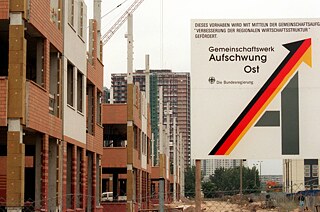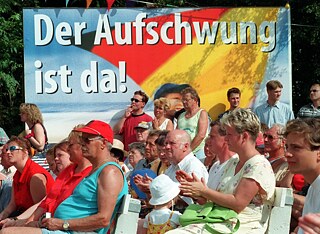Following reunification in 1990, Germany had to undertake unprecedented efforts – above all in financial terms – to merge the two German states. The consequences can still be felt to this day.

In the early days of Germany’s reunification, budget funds were channelled for the most part to the east: the “Aufschwung Ost” (Upswing East), an economic programme costing billions, was followed by the Solidary Pacts I and II. | © Adobe/Picture Alliance
It quickly became apparent that even the comparatively rich western part of the country would not achieve this without additional revenue. Helmut Kohl, who was chancellor at the time, had still been promising in 1990 that no tax hikes would be necessary to fund German unity – yet just a year later he reneged on this promise. A glance at the figures 25 years on makes the dimensions abundantly clear: by 2015, reunification was estimated to have cost as much as two trillion euros.
The high costs of rebuilding the east
It was not only ordinary citizens but also businesses and associations that were required to put their hands in their pockets in various ways to rebuild the eastern part of the country. For example, employees and employers alike had to pay higher contributions to health, pensions and unemployment insurance. These increased premiums were used to pay for the 15 million or so new citizens to be integrated into West Germany’s social welfare system. No such funds had existed in the former GDR, as social welfare benefits there had been provided by the state.
In May 1991, Germany’s parliament – the Bundestag – decided to introduce another source of finance, known as the solidarity surcharge. All taxpayers, including businesses, had to pay an additional levy on top of their income or profit tax. Initially, this amounted to 7.5 percent of their normal tax burden, meaning that anyone liable for 10,000 deutschmarks (Germany’s currency before the euro) in tax per year was then obliged to pay an additional 750 deutschmarks to the inland revenue. This meant that at least part of the herculean task was spread across the entire population. East Germans also had to pay the solidarity surcharge, which was intended to cover the costs of rebuilding their part of the country.

“Der Aufschwung ist da!” (The upswing has arrived!): 1998 CDU election poster in Kühlungsborn in the eastern German state of Mecklenburg-Western Pomerania. Under CDU Chancellor Helmut Kohl, not only the “soli” but also economic programmes costing billions had been introduced to rebuild the east of Germany. | © Adobe/Picture Alliance
One year of solidarity was not enough
Originally, the “soli”, which is how the solidarity surcharge came to be known colloquially, was only supposed to remain in force for one year. And indeed the tax was not levied in 1993 or 1994. However, the problems of the east German economy had worsened in the meantime, partly because its traditional trade links to Eastern Europe had collapsed, with the result that the “soli” was reintroduced in 1995. Though lowered to 5.5 percent three years later, it was to remain in place for a very long time in this form. It is only since 2019 that the surcharge has only been payable by taxpayers on particularly high incomes.
While acceptance of the soli was pretty high at first, this was to change over time. This is because funds were transferred primarily to eastern Germany in the first years after reunification to pay for the decrepit road and rail infrastructure to be modernized and provide sizeable grants to attract businesses to relocate. The revenue that privatization of the former state economy was hoped to generate failed for the most part to materialize; companies were no longer able to compete once the deutschmark was introduced in the new states, and their equipment and products were outdated. Consequently, funds from the budgets of west German states were redirected to the eastern part of the country: known as the solidarity pact, this programme was intended to iron out the differences between rich and poorer German states.
Other regions were the losers of German unity
This redistribution of funds within the country already led to resentment in structurally weak regions of the West in the 1990s. Citizens and local politicians felt that they had been abandoned to deal with their problems on their own. While wealthy centers in eastern Germany gradually began reaching Western standards of prosperity, cities in the Ruhr region drifted into poverty.
There was also fundamental criticism of the solidarity surcharge because nobody knew exactly what the 300 billion euros had been spent on. Since German tax law does not allow tax revenues to be earmarked for a specific purpose, the money ended up in the federal coffers. Although the federal government certainly did invest large sums in the eastern part of the country, some calculations carried out starting in the 2010s concluded that the revenue generated by the soli exceeded the expenditure on rebuilding the east.
In addition, an additional levy of this kind must be limited to the period of additional financial burden. Multiple lawsuits were brought against the soli, claiming that there were doubts over whether this additional financial burden had existed all the time. Nonetheless, Germany’s Federal Fiscal Court has so far confirmed that the soli is lawful. Even though now paid only by certain taxpayers and companies, the soli still generates billions in revenue for the state – and the debate on when to abolish it once and for all continues. The Federal Constitutional Court in Karlsruhe is set to announce its highly anticipated ruling on the solidarity surcharge on March 26, 2025.
Editor's note, March 26, 2025:
The German Federal Constitutional Court has upheld the requirement for the solidarity contribution to continue. However, this contribution will now only be required from the top 10% of taxpayers. Additionally, the surcharge will be applied to capital gains and corporation tax.
